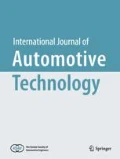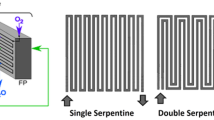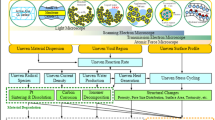Abstract
The water balance in the membranes of a polymer electrolyte membrane fuel cell (PEMFC) is a crucial factor in the maintenance of the proton conductivities. At the same time, the water generated in the catalysts must be removed to prevent flooding on the cathode side, which blocks oxygen from reaching the catalyst. Because of these somewhat contradictory requirements, attention must be paid to water management, which directly affects the performance and durability of the PEM fuel cell. A gas-to-gas humidifier constructed with membranes is the most feasible solution and can humidify the stack in mobile applications because it requires no extra power supply or moving parts, which in turn provides advantages for the design of vehicles. This work proposes a mathematical model that describes the behavior of a humidifier constructed with a shell and tubes that employs the heat and mass transfer principles of thermodynamics. The results from simulations are compared with experimental data. In addition, analyses of the static and dynamic behaviors of the humidifier are conducted while considering the geometric design parameters and operating conditions. Finally, the dynamic response to variations in the flow rate is investigated.
Similar content being viewed by others
References
Biao, Z., Wenbo, H., Yi, Z. and Andrzel, S. (2006). Water and pressure effects on a single PEM fuel cell. J. Power Sources, 155, 190–202.
Carlson, E. J., Kopf, P., Sinha, J., Sriramulu, S. and Yang, Y. (2005). Cost Analysis of PEM Fuel Cell Systems for Transportation. Subcontract Report.
Ceraolo, M., Miulli, C. and Pozio, A. (2003). Modeling static and dynamic behavior of proton exchange membrane fuel cell on the basis of electrochemical description. J. Power Sources, 113, 131–144.
Dongmei, C. and Peng, H. (2005). A thermodynamic model of membrane humidifiers for PEM fuel cell humidification control. J. Dynamic System, Measurement and Control, 127, 424–432.
Incropera, F. P. and Dewitt, D. P. (1996). Fundamentals of Heat and Mass Transfer. 4th edn.
Ito, T., Yuan, J. and Sunden, B. (2006). Water recover schemes and effect on the water/thermal balances for a 100kw PEMFC system. The 2nd Int. Conf. Fuel Cell Science, Engineering and Technology, No. FUELCELL 2006-97114.
Jung, S. Y., Jonathan, P. and Constance, K. (2006). Porous bipolar plate with interdigitated flow fields for PEM fuel cells. UTC Fuel Cells.
Larminie, J. and Dicks, A. (2003). Fuel Cell Systems Explained. 2nd edn. Wiley. England.
Nguyen, T. V. and White, R. E. (1993). A water and heat management model for proton-exchange-membrane fuel cells. J. Electrochemical Society 140,8, 2178–2186.
PermaPure LLC (2006). http://www.permapure.com/Presentations/Fuel%20Cell%20Humidification%20presentation.ppt.
Qiangu, Y., Hossein, T. and Junxio, W. (2006). Investigation of water transport through membrane in a PEM fuel cell by water balance experiments. J. Power Sources, 158, 316–325.
Quan, P. and Lai, M. C. (2007). Numerical study of water management in the air flow channel of a PEM fuel cell cathode. J. Power Sources, 164, 222–237.
Ren, X. and Gottesfeld, S. (2001). Electro-osmotic drag of water in a poly (perfluorosulphonic acid) membrane. J. Electrochemical Society 148,1, A87–A93.
Sonntag, R. E., Borgnakke, C. and Van Wylen, G. J. (1998). Fundamentals of Thermodynamics. 5th edn. Wiley. New York.
Springer, T. E., Zawodzinski, T. A. and Gontesfeld, S. (1991). Polymer electrolyte fuel cell model. J. Electrochemical Society 138,8, 2334–2342.
Thomas, A. Ghassemi, H., Every, H., Karuppaiah, C., Chou, B., Kalapos, T., Pelsozy, M., Subaraman, R., Pivovar, B., Kerr, J. and Weiss, R. (2004). Hightemperature membranes. DOE Hydrogen Program. FY 2004 Progress Report. 309–314.
Wood, D. L., Yi, J. S. and Nguyen, T. V. (1998). Effect of direct liquid water injection and interdigitated flow field on the performance of proton exchange membrane fuel cells. Electrochemica ACTA, 43, 3795–3809.
Xiuqin, Z., Juncheng, G. and Jincan, C. (2010). The parametric optimum analysis of a proton exchange membrane (PEM) fuel cell and its load matching. Energy, 35, 5294–5299.
Zawodzinski, T. A., Derouin, C., Radzinski, S., Sherman, R. J., Smith, V. T., Springer, T. E. and Gottesfeld, S. (1993). Water uptake by and transport through Nafion 117 membranes. J. Electrochemical Society 140,4, 1041–1047.
Author information
Authors and Affiliations
Corresponding author
Rights and permissions
About this article
Cite this article
Park, S.K., Choe, S.Y., Lim, T.W. et al. Analysis of a shell-and-tube type gas-to-gas membrane humidifier for an automotive polymer electrolyte membrane fuel cell power system. Int.J Automot. Technol. 14, 449–457 (2013). https://doi.org/10.1007/s12239-013-0049-4
Received:
Revised:
Accepted:
Published:
Issue Date:
DOI: https://doi.org/10.1007/s12239-013-0049-4




